Content
Albert Einstein
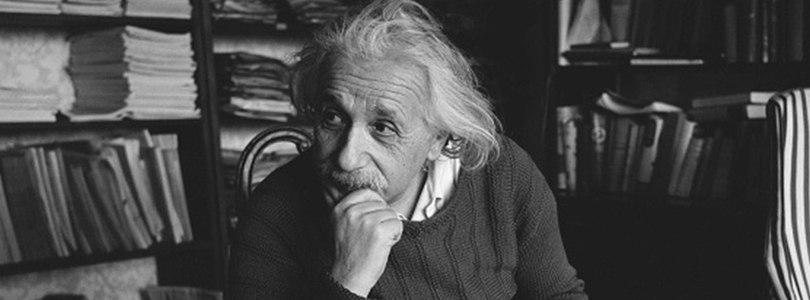
Albert Einstein, February 1, 1944
The best-known patent examiner of all time
A genius of the century, an icon of the natural sciences, the most famous physicist of all time: With Albert Einstein, you run out of superlatives. It is not generally known that Einstein, who died 70 years ago on April 18th, 1955, also was a patent examiner and inventor.
Man of the century
The American magazine "Time" voted Einstein ![]() "Person of the Century" in 1999. Einstein's multifaceted biography reflects the eventful 20th century: The talented young libertine who struggles with the authoritarian educational institutions of the German empire. The unrecognised genius who has to keep his head above water for a long time by earning a living. The passionate pacifist who witnesses two world wars and demands the development of the atomic bomb against his conviction. The globally acclaimed scientist who is discredited and persecuted at home. The Jewish refugee who has to leave his country of birth, whose cousin is murdered in a concentration camp and who finds his new home in the USA. The fighter for peace, reason, disarmament and tolerance, who wants to curtail the nuclear threat which he himself had paved the way for.
"Person of the Century" in 1999. Einstein's multifaceted biography reflects the eventful 20th century: The talented young libertine who struggles with the authoritarian educational institutions of the German empire. The unrecognised genius who has to keep his head above water for a long time by earning a living. The passionate pacifist who witnesses two world wars and demands the development of the atomic bomb against his conviction. The globally acclaimed scientist who is discredited and persecuted at home. The Jewish refugee who has to leave his country of birth, whose cousin is murdered in a concentration camp and who finds his new home in the USA. The fighter for peace, reason, disarmament and tolerance, who wants to curtail the nuclear threat which he himself had paved the way for.
A genius's teething troubles
Einstein was born on 14 March 1879 in Ulm. His young years were not a success story ("The really important things are learned differently than by words," he should say later): He dropped out of high school in Munich and failed to pass the entrance examination at the Polytechnikum Zürich (now the Swiss Federal Institute of Technology). After he had completed his "Matura" in Aarau (contrary to legend, with quite good grades!) and successfully graduated as a subject teacher for mathematics and physics in Zurich, he repeatedly applied for academic assistant positions without success. He was forced to make a living as a temporary teacher and tutor and lived at the subsistence level.
In the end, his connections got him out of this Situation. His friend Marcel Grossmann was a friend of Friedrich Holler, Director of the Swiss Patent Office (![]() Swiss Federal Institute of Intellectual Property) in Bern. Despite an interview that did not go well, Einstein was recruited as a probationary patent examiner.
Swiss Federal Institute of Intellectual Property) in Bern. Despite an interview that did not go well, Einstein was recruited as a probationary patent examiner.
"Third Grade Expert"
From 23 June 1902 Albert Einstein worked as a "third class technical expert" and examined patent applications in the mechanical field. He received 292 Swiss francs a month which was enough to make a living without need back then.
Einstein saw his work as a patent examiner as a "bread-and-butter profession", which did not fully satisfy him; in his spare time he devoted himself to theoretical physics and worked on his doctoral thesis. Later he wrote that "the peace of the secular monastery and the material reassurance for the hard times" were very helpful for him. Here, for example, he examined gravel sorting machines( ![]() CH39561) and weather indicators (
CH39561) and weather indicators ( ![]() CH39619 ). While working on his standing desk in room 86 at the corner of Speichergasse and Genfergasse, the young patent examiner sometimes picked up the violin which allegedly helped him to think.
CH39619 ). While working on his standing desk in room 86 at the corner of Speichergasse and Genfergasse, the young patent examiner sometimes picked up the violin which allegedly helped him to think.
When his probationary period ended in 1904 he was employed on a permanent basis. At first a promotion was postponed because the director of the patent office thought that Einstein would have to become better acquainted with mechanical engineering. Probably he was actually somewhere else with his thoughts: 1905 went down in the history of science as the "annus mirabilis". Einstein published some of his most important works, including the treatise on the photoelectric effect (for which he later received the Nobel Prize) and the special theory of relativity (with the famous formula E = mc²). In short: An "explosion of genius" (C.F. v. Weizsäcker).
“Riding maths, scratching the violin”
Einstein described his time as an examiner in a letter: "I'm fine; I'm a venerable Swiss “Tintenscheißer” (ink shithead) with a decent salary. Besides I ride on my old mathematical-physical hobby-horse and scratch on the violin". In April 1906 he was promoted to "second class expert". His monthly salary increased to 375 Swiss francs.
He had successfully submitted his doctoral thesis in 1905, but his habilitation was initially rejected by the University of Bern in 1907. Only one year later was he successful and was now able to work as a part-time private lecturer. He gave his lectures before or after his working hours at the patent office: from 7 a.m. to 8 a.m. or from 6 p.m. to 7 p.m.. In the first semester he is said to have had only three listeners, including two colleagues from the Patent Office.
Einstein's most fertile years

Einstein at his arrival in New York, 1921
In the peace and tranquillity of his office, a flash of inspiration came to him in 1907, which he later described as "the happiest thought of my life": "I was sitting on my armchair in the Bern Patent Office, when suddenly the following thought occurred to me: 'If a person is in free fall, he does not feel his own weight'. I was amazed. This simple thought made a deep impression on me. It drove me in the direction of a "theory of gravity" - and thus on the way to the general theory of relativity.
Einstein worked at the Swiss Patent Office for seven years. Today he is regarded as the most famous of all patent examiners (but in view of his intensive side jobs he was probably not the best...). In 1909 he finally received an extraordinary professorship for theoretical physics at the University of Zurich and was able to devote himself exclusively to science. But perhaps his most important work came about during his time as a patent examiner.
Einstein as patent assessor and inventor
Even later, when Albert Einstein had long since achieved fame and honours, he continued to deal with patents: Between 1915 and 1928, Einstein prepared various court opinions on patent disputes, but also private expertises for companies.
One example: In the proceedings concerning the infringement of a patent on a gyrocompass, which the Kiel entrepreneur Hermann Anschütz-Kaempfe had applied for at the Kaiserliches Patentamt in 1905, Einstein was called in as an expert witness. After initial hesitation, he became very intensively involved with the gyrocompass, first proving the infringement of the patent and then participating in its further development himself. For his inventive contribution, which is probably behind claim 4 of ![]() DE394667A , Einstein is said to have received a share of the sales proceeds for years. In Kiel today, a memorial commemorates the collaboration of the two enthusiastic amateur sailors on the gyrocompass.
DE394667A , Einstein is said to have received a share of the sales proceeds for years. In Kiel today, a memorial commemorates the collaboration of the two enthusiastic amateur sailors on the gyrocompass.
The former patent examiner had long since become a Nobel laureate, an honorary doctor of various universities and the director of the Kaiser Wilhelm Institute for Physics in Berlin, when he began to become more active as an inventor in the mid-1920s.
Einstein and Szilard reinvent the refrigerator
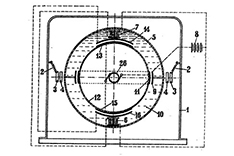
Drawing from DE394667A
An accident provided the impetus: a newspaper reported that a family had been killed in their sleep by toxic fumes of a refrigerant leaking from the defective pump valve of a refrigerator. Einstein was so concerned that he started looking for a new, non-hazardous refrigeration system. He was assisted by one of his students: Leo Szilard. The Hungarian was just growing up to become one of the greatest nuclear physicists, later worked in the USA with Enrico Fermi on the first atomic reactor and remained close to Einstein throughout his life.
Einstein and Szilard designed a refrigerator with an electromagnetic pump (without a valve). In total, the two received ten patents from the Reichspatentamt and 12 more abroad for their refrigerating machines, pumps, compressors and processes for refrigeration, which they applied for between 1926 and 1932 (e.g. ![]() DE563403A,
DE563403A, ![]() DE565614A).
DE565614A).
But they didn't get much out of it: none of their refrigerators ever went into serial production. The Swedish company Elektrolux AG bought two of the patents, but did not use them. AEG bought the licence for an electromagnetic pump, but nothing more than a prototype came of it. The failure was also due to the discovery of a new, low-risk refrigerant in 1929: chlorofluorocarbon (CFC).
Katzbuckel and hearing aid
Einstein had also studied the flow behaviour of aircraft wings earlier and developed a new airfoil shape. The wings were called "Katzbuckel wings" because of their shape, but they failed a practical test.
Together with the Berlin engineer Dr. Rudolf Goldschmidt, Einstein applied for a patent for a bone-conducting hearing aid at the Reichspatentamt in 1929. The suggestion probably came from a neighbour, a singer who was hard of hearing. When the patent was granted ( ![]() DE590783A, 21.12.1933), the Reichspatentamt named the inventor "Dr. Albert Einstein formerly in Berlin, current residence unknown": Einstein had stayed in the USA on a trip after the National Socialists came to power.
DE590783A, 21.12.1933), the Reichspatentamt named the inventor "Dr. Albert Einstein formerly in Berlin, current residence unknown": Einstein had stayed in the USA on a trip after the National Socialists came to power.
He never returned to Germany.
Geniuses among themselves
When Einstein met Charlie Chaplin at a film premiere in 1931, the following dialogue is said to have taken place:
Einstein: "What I admire most about your art is its universality. You don't say a word, but the whole world understands you!"
Chaplin: "Right. But your art is even greater! The whole world admires you, even if nobody understands a word of what you say."
Text: Dr. Jan Björn Potthast; Pictures: Getty Images / Popperfoto, Lucien Chavan / ETH Zürich (Public domain, via Wikimedia Commons), Underwood and Underwood New York Library of Congress Public domain via Wikimedia Commons, Ferdinand Schmutzer / Public domain via Wikimedia Commons, DEPATISnet, DEPATISnet, Photoplay Publishing (Public domain, via Wikimedia Commons)
Last updated: 10 December 2025

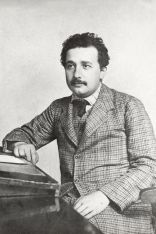
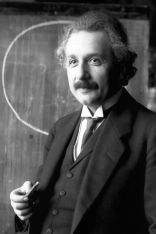
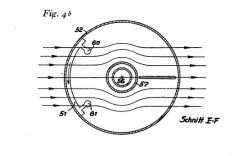
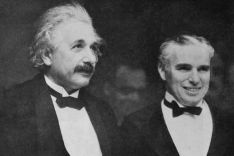
Not only protecting innovations
Social Media